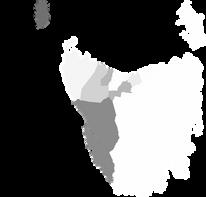




Empowering the region through strategic partnerships in readiness for the future.

We pay respect to and acknowledge the traditional custodians of lutruwita (Tasmania): the Palawa/Pakana.
We recognise and celebrate the Tasmanian Aboriginal peoples’ survival and continued connection with the land, spanning more than 40,000 years. This is a very important part of our region’s story.
Original artwork by Krakani Creations.

Our Organisation:
Cradle Coast Authority (CCA) was established in 1999. It is jointly owned by eight of the nine regional Councils, with the purpose of building a stronger region.
CCA's three operating functions are Strategic Services, Natural Resource Management (NRM) and Regional Development. Our work is guided by the Representative's Letter of Expectation (LoE), which is our overarching document, along with the 2030 NRM Strategy and Regional Futures Plan.
Our Staff:
Our Vision:
A strong, resilient, and sustainable North Western and Western Tasmanian region built through partnership with Council, Community, Business and Industry.
Our Purpose:
Advocate, lead, support, facilitate and foster; innovation, regional planning, investment, economic and environmental management across the region.
Our Region:
The Cradle Coast is a diverse region which spans across the North West and Western Tasmania.


Our Member Councils:



SP 1: Regional Advocacy
SP 2: Strategic Alignment
Position CCA as a regional partner –facilitating, collaborating, enabling and acting on behalf of Councils.

Set regional priorities annually with Member Councils, through a priority setting process, with a focus on building a stronger region Monitor, evaluate and review CCA’s Advocacy, Communication and Engagement Strategy.
Identify and secure financial and policy support for regional priorities i.e., NRM projects, Regionally Important Projects, Shared Services and other initiatives undertaken by CCA on behalf of Councils.
Foster strong partnerships with all stakeholders and use CCA's communications platforms to promote an integrated approach to Regional Development, NRM and Local Government.

SP 3: Governance and Management
Cross reference and align all CCA plans within a single business or organisational framework.
Develop a masterplan, an organisational framework, incorporating the key functions of CCA as described in the Letter of Expectation (LoE), NRM Strategic Plan and Regional Futures Plan.
Deliver government-funded projects
Work with Member Councils to develop opportunities that will increase the Shared Services capabilities.
SP 4: Financial Sustainability
Work with all stakeholders to ensure that CCA's governance and management structures are fit for purpose.
Undertake a review of existing governance structure and connected policies and processes.
In response to the review, modify or change existing governance structure to ensure it is fit for purpose and drives high levels of engagement with Councils.
Build a review cycle into CCA governance, including Board and Director evaluation.
Implement a review cyc e for al CCA team members to evaluate effectiveness within a culture of growth and development
Develop an evaluation matrix to measure success against the projects, priorities and outputs of each business unit.
Develop a financial roadmap for the future of CCA.
Explore different funding methodologies, including the establishment of fee-for-service business unit.
Define and deliver services to Councils and where appropriate to community - NRM, Regional Development etc.
Prioritise resources to enable a future focused sustainable organisation
Seek funds through partnerships and budget and grant submissions.
Monitor performance against Financial Management Plan.

Position CCA as a regional partner – advocating, facilitating, collaborating, enabling and acting on behalf of Member Councils.
Set regional priorities annually with Member Councils, through a priority setting process, with a focus on building a stronger region.
Monitor, evaluate and review CCA’s Advocacy, Communication and Engagement Strategy.
Identify and secure financial and policy support for regional priorities i.e., NRM projects, Regionally Important Projects, Shared Services and other initiatives undertaken by CCA on behalf of Councils.
Foster strong partnerships with all stakeholders and use CCA's communications platforms to promote an integrated approach to Regional Development, NRM and Local Government.
Use the Advocacy, Communication and Engagement Strategy to plan, coordinate, facilitate, advocate and act on behalf of Councils as determined via the prioritisation process.
Advocacy evaluation provided in the CCA Annual Report.
Stakeholders report that they have a understanding of value that CCA brings to the region - individually and collectively.
The Regional Investment Framework supports proponents in achieving regional objectives.

Cross reference and align all plans within a single business or organisational framework.
Develop a masterplan, an organisational framework, incorporating the key functions of CCA as described in the Letter of Expectation (LoE), NRM Strategic Plan and Regional Futures Plan.
Deliver government-funded projects.
Work with Member Councils to develop opportunities that will increase the Shared Services capabilities.
Balance economic, social, cultural and environmental opportunities within the region.
The organisational structure supports the form and function of CCA by having the right people, skills, culture and processes required to deliver on the LoE, NRM Strategy and Regional Futures Plan.
Deliver priority regional development and NRM projects on-budget and on-time.
The provision by CCA of a suite of services to Councils.
Economic development work is informed and improved through the inclusion of an NRM perspective and vice versa.

Work with all stakeholders to ensure that CCA's governance and management structures are fit for purpose.
Undertake a review of existing governance structure and connected policies and processes.
In response to the review, modify or change existing governance structure to ensure it is fit for purpose and drives high levels of engagement with Councils.
Build a review cycle into CCA governance, including Board and Director evaluation.
Implement a review cycle for all CCA team members to evaluate effectiveness within a culture of growth and development.
Develop an evaluation matrix to measure success against the projects, priorities and outputs of each business unit.
CCA's organisational structure and business plan reflects the recommendations of the CCA’s governance review.
Clear management accountability for contracts and statutory obligations and timelines.
Increased visibility and reputation of the CCA; regular, transparent, and meaningful evaluation and reporting to our owners and external stakeholders.
Retain, recruit and build a high performing organisation.

Develop a financial roadmap for the future of CCA.
Explore different funding methodologies, including the establishment of fee-for-service business unit.
Define and deliver services to Councils and where appropriate to community - NRM, Regional Development etc.
Prioritise resources to enable a future focused sustainable organisation.
Seek funds through partnerships and budget and grant submissions.
Monitor performance against Financial Management Plan.
Comply with the Financial Management Plan to inform decision-making.
Secure investment to grow the financial base of CCA, in addition to Council and other Government revenue.
Representatives and Board of Directors support CCA's financial diversification.
Clear understanding of value proposition and core assets to protect.